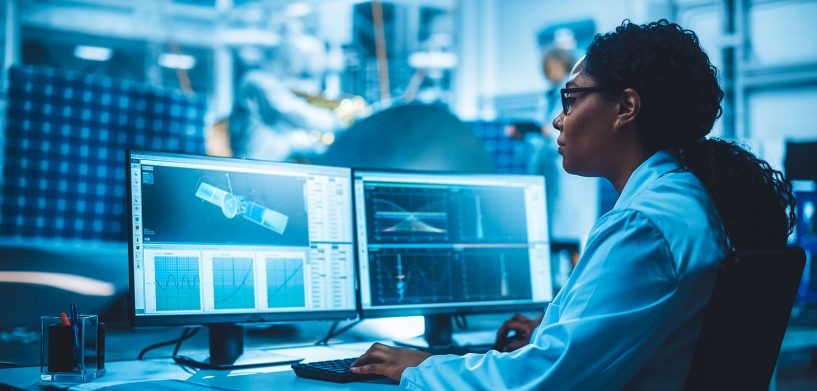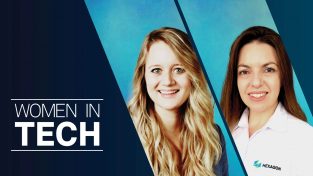Recognising a need to increase participation of women in STEM fields, the United Nations Educational, Scientific and Cultural Organization (UNESCO) first designated Feb. 11 as International Day of Women and Girls in Science in 2015. Hexagon supports the promotion of gender diversity across the industry and within our organisation through our culture and people initiatives.
From lead engineers to product managers, women play a key role in scientific innovation and development at Hexagon. Here is a small snapshot of some of the notable women currently making global navigation satellite system (GNSS) history across the Hexagon’s Autonomy & Positioning division.
Jennifer Busser, product manager of correction services at Hexagon | NovAtel, graduated with a Bachelor of Science in Geomatics Engineering in 2018 followed by a 16-month internship at Hexagon and two summers of GNSS research with the University of Calgary Geomatics Department. She has a passion for connecting people to the world of GNSS positioning and today works closely with Hexagon’s engineering teams to bring breakthrough PPP technologies to new and diverse applications.
Busser also advocates for sharing this exciting field with fresh minds through her efforts with student outreach and engagement programs to bring awareness to the innovations and opportunities in this space. You can see an example of Busser’s work in her Intro to GNSS episode on Reducing GNSS Errors.
Lily Huang is a firmware engineer at NovAtel focusing on improving GNSS tracking and timing design, implementation and testing. Through her engineering work, she has enhanced the Fast Fourier Transform (FFT) search used to acquire and re-acquire GNSS signals.
During NovAtel’s 2021 Innovation Week – a week dedicated for engineers to develop their projects – Huang and her team refined their FFT project to gain an additional six decibels of FFT re-acquisition sensitivity. The FFT search has a longer outage time advantage to re-acquire GNSS signals when a positioning application experiences signal interruptions. This project is just one of several examples of Huang pushing the envelope of what is possible with GNSS firmware.
While completing her Master’s in Geomatic Engineering at the University of Calgary, Erin Kahr operated the first NovAtel receiver to fly in space on the CanX-2 CubeSat. Her passion for space technologies motivated her to complete her doctorate jointly at the University of Calgary and the German Space Centre (DLR), studying the use of GNSS technologies on spacecraft orbiting above positioning satellites.
Currently, Kahr works with the correction services team at NovAtel as a geomatics engineer. Her team is designing ways to improve GNSS corrections for use with autonomous vehicles. You can read about her work on GNSS positioning on spacecraft in “Carrier Phase-Based Relative Positioning above the GNSS Constellations” (E. Kahr, K. O’Keefe and H. Filippi, Proceedings of ION GNSS+ 2018, Miami, FL, pp 1675-1690).
Sandy Kennedy, Hexagon’s Autonomy & Positioning division’s VP of innovation, graduated with her Master of Science in Geomatics Engineering in 2002, focusing on integrating GPS and inertial navigation sensors. But her first patent did not have any inertial components: “Method for positioning using a GPS in a restrictive coverage environment” (US 7529770). You can read more about her early GNSS+INS work in the 2005 publication, “Integration of Inertial Measurements with GNSS – NovAtel SPAN Architecture” (S. Kennedy and J. Hamilton, in Proc. Symposium Gyro Technology, Stuttgart, Sept. 2005).
Graduating with a Master of Science in Geomatics Engineering specialization in position, navigation and location in 2016, Laura Norman works as a geomatics engineer in the safety-critical systems department at NovAtel. With her current focus on GNSS integrity, she has played a key role in several publications and research projects, including this presentation on Integrity Performance for Precise Positioning in Automotive. Norman was elected as a technical representative on the Institute of Navigation’s 2021-2023 council.
Encouraging women and girls in STEM
Below are resources to continue supporting and encouraging women and girls to pursue scientific careers and interests:
Learn more about UNESCO’s International Day of Women and Girls in Science
Participate in International Women in Engineering Day
Discover advocacy efforts and more from the Association for Women in Science
Learn about women making history at NASA
Introduce young girls to the science behind GNSS in a science project at home
[Related content — Women in Tech: Leading the way with innovation]

















